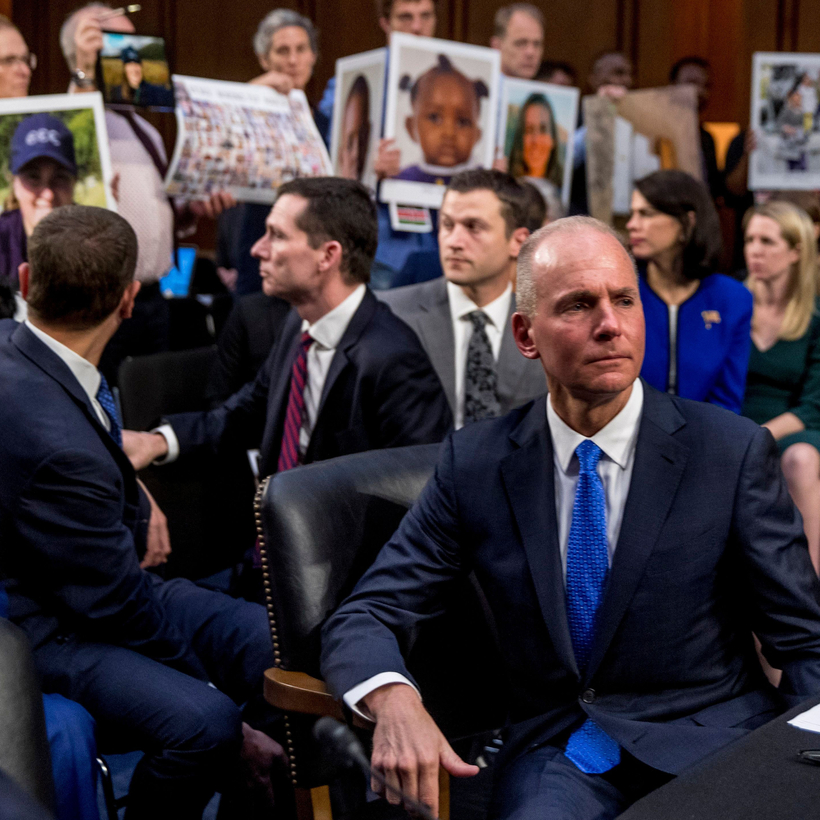It was the Perry Mason moment of the hearings that riveted the world. As Boeing C.E.O. Dennis Muilenburg—sweaty, teary, apologetic, but still robotically defensive of his company—sat before Congress in October 2019, he faced hostile questions from Texas senator Ted Cruz. The subject was a set of smoking-gun internal messages between two Boeing pilots.
One pilot had experienced a hairy ride in a 737 MAX simulator, months before that plane was to be delivered to airlines—apparently the result of faulty software design, the kind of glitch that should have been ironed out months, if not years, prior. The software would later be blamed for two deadly crashes of the MAX (in the Java Sea, shortly after taking off from Jakarta, in October of 2018; and in Ethiopia, shortly after taking off from Addis Ababa, in March of 2019).
“Mr. Muilenburg, I have to say the testimony here today has been quite dismaying,” Cruz began, relishing the buildup. He picked up a copy of the instant messages in question, the paper cup of coffee next to him making it clear he was fully caffeinated. “Th[is] exchange describes what happened in Lion Air and Ethiopian Air. [Their loved ones] are gathered here.... Three hundred and forty-six people are dead because of what these chief pilots described as ‘egregious’ and ‘crazy’—that’s their language, that’s Boeing’s internal language.” In the audience, one woman wiped away tears, the man next to her rubbing her back.
The words Cruz cited were those of Boeing pilot Mark Forkner. He’d been the primary liaison to the F.A.A. about the MAX’s manual—the guidebook that was supposed to offer pilots all they needed to know to operate the brand-new plane.

But that manual failed to address a piece of software known as the Maneuvering Characteristics Augmentation System, or M.C.A.S., which had the power to tip the plane’s nose down in certain situations. (The only reference to M.C.A.S. was in the manual’s glossary.) In Forkner’s instant messages, he complained that no one had told him that the software’s reach had been expanded late in flight testing. Designed to kick in at high speeds, engineers had extended its authority to low speeds—and thus during the most perilous moments of flight, at takeoff and landing. After his harrowing ride in the simulator, Forkner vented to his colleague that he’d “lied (unknowingly)” to the F.A.A. about how the software worked—and its potential flummox points.
Muilenburg pleaded ignorance about Forkner, who’d since left Boeing for another job. Boeing itself had handed his messages to the authorities—first to investigators at the Department of Justice and then, just before the hearing, to congressional committees. (A House staffer got a call from someone at Boeing suggesting he look at the one at the top.) “We’re not quite sure what Mr. Forkner meant—his lawyer has suggested he was talking about a simulator that was in development,” the C.E.O. said.
One pilot had experienced a hairy ride in a 737 MAX simulator, months before that plane was to be delivered to airlines.
The lawyer Muilenburg referred to was David Gerger of Houston, no stranger to corporate scandal—his clients have included the former C.F.O. of Enron and a BP engineer accused of manslaughter in the Deepwater Horizon blowout. Such representation doesn’t come cheap; Forkner’s former colleagues wondered among themselves how a man who regularly wore a Seahawks jersey could afford such a high-powered attorney.

An answer would emerge. While Muilenberg’s remarks might have suggested distance between the C.E.O. and his former employee, Gerger was being paid for by none other than Boeing’s own liability insurance policy, according to people familiar with the matter.
It was part of a larger effort to keep the various inquiries into the company’s actions under control. In other words, if the C.E.O. had wanted to dig more deeply into what went wrong and when, as Cruz’s interrogation suggested, he very well could have.
Just over a year later, the Justice Department would levy what it called a $2.5 billion “fine” on Boeing. The bulk of the fine, though, comprised $1.77 billion in compensation to Boeing’s airline customers and $500 million in settlements to victims’ families—money Boeing would probably have paid anyway. The amount of its criminal penalty was $243.6 million, a significant number but modest next to profits of $8.2 billion in 2017, the year of the MAX’s first deliveries.
In his last year at Boeing, Muilenburg received stock worth as much as $39 million in addition to $4 million in salary and other benefits. He left with a pension worth $15 million, and earned more than $120 million in compensation from 2011 to 2019.
Meanwhile, the only person criminally charged in the 737 MAX affair so far has been Forkner, who faces trial in Fort Worth, Texas, on a charge of fraud for withholding information from regulators. He has pleaded not guilty.
Peter Robison’s Flying Blind: The 737 MAX Tragedy and the Fall of Boeing is out now from Doubleday

